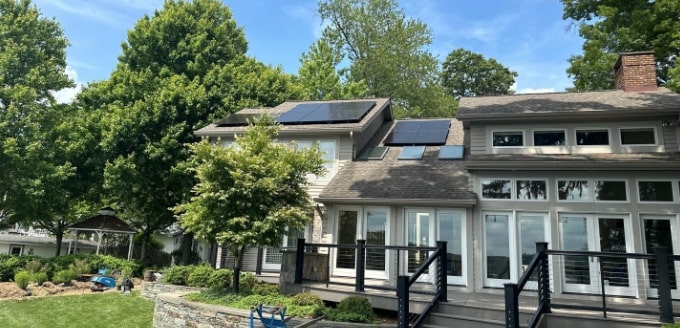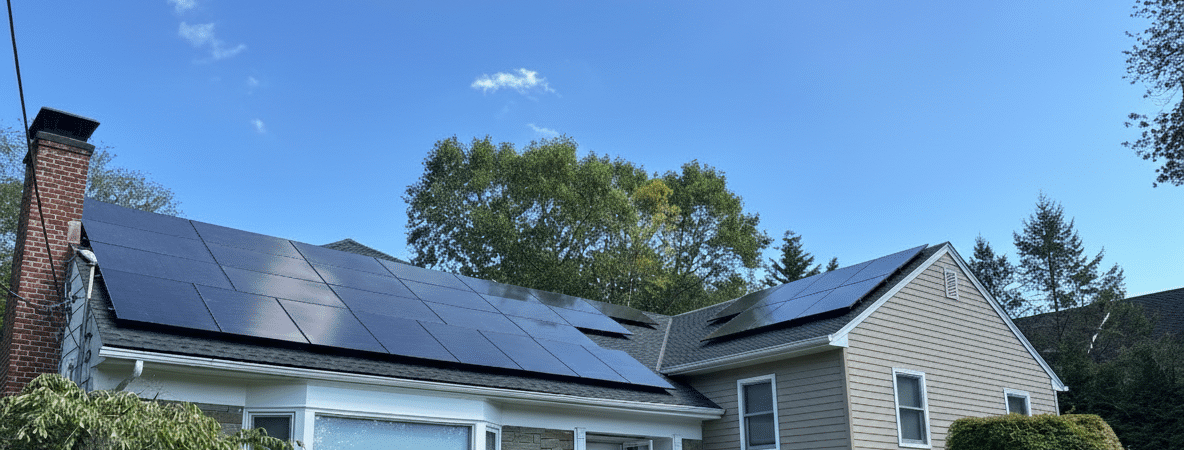There are several ways solar panels can reduce electric bill in New Jersey. Undoubtedly, one of the biggest reasons customers choose to go solar is to reduce electricity costs. In New Jersey, the average electric bill is over $100. Over a year, this means homeowners typically incur over $1200 in expenses. As a homeowner, you need to know how switching to solar can dramatically reduce or eliminate your electric bill. This way, you can better understand how solar investments pay off over time. Read on to learn about the most important ways solar panels can reduce electric bill in New Jersey.
Energy-Efficient Panels
First, energy-efficient panels are key to lower electric expenses in New Jersey. Typically, solar panel models range from about 15 to 20% in energy efficiency ratings. To increase your monthly electric savings, you should look for a solar contracting company who offers highly efficient panels. For example, Infinity Energy offers LG solar panels. Notably, this solar brand has been a consistent market leader in solar panel efficiency, with many models at 20% or higher. In addition, LG typically guarantees a power output of over 90% over 25 years. This way, you can continue to generate larger amounts of energy when you buy rooftop solar Hunterdon County and other areas. Definitely, energy-efficient panels are essential to reduce electrical expenses in NJ.
Micro Inverters
Next, you can maximize your electric savings in New Jersey by selecting a micro inverter for your solar system. Importantly, micro inverters are responsible for converting the direct current (DC) from the sun into usable alternating current (AC) to power your home. In a micro inverter system, units are placed behind every single panel in your solar array. With this configuration, they can capture all of the available electricity from each individual solar panel and convert it onsite to usable AC. In a regular string inverter system, solar modules are wired together. This makes the output depend on the worst-performing panel. Notably, micro inverters are more efficient. Even if one panel has a shading issue, you can still collect maximum energy from your other panels. Absolutely, micro inverters’ energy efficiency is key to maximize NJ electric savings.
Net Metering
In addition, net metering is a great way to maximize your New Jersey solar energy investments. With net metering, you can receive credit on your utility bill for excess energy that your system produces. For example, customers might generate more energy than they need during the summer months when sun exposure is higher. Typically, your utility company will use this energy. Then, you will receive credit on your utility bill for the kWh your home did not use. Typically, these credits are valued at the full retail value of the electricity production. Once your utility company pays you back for your excess kWhs, you can use them as needed to supplement your rooftop solar solutions NY and NJ. Certainly, net metering is a great way to reduce monthly electric bills with solar in NJ.
Solar Batteries
Moreover, a solar battery can also reduce electric bills in New Jersey. Typically, utility companies charge a demand fee based on the maximum amount of electrical energy consumed at a given time during the month. Notably, you can reduce this fee by using a solar battery system to store energy. Solar battery systems detect when energy usage is increasing. When the solar panels are not producing enough energy to meet the demand, the batteries kick in, keeping your system from drawing from the grid. Notably, solar batteries are highly effective for reducing the usage spike that often cause high demand charges. Therefore, ask your installer about solar batteries to reduce NJ electric costs.
Low Maintenance
Furthermore, switching to solar power significantly reduces electric maintenance charges in New Jersey. Once your solar installation Passaic County NJ and other areas is completed, it is rare for solar panels to require maintenance or repairs. Indeed, many companies simply recommend using a garden hose to wash dust and debris from your panels. In addition, most reliable solar contractors offer customers a 25-year equipment warranty. If your panels become damaged from storm debris within the warranty period, this means you can get a replacement at no cost. Often, customers have issues with high electric costs and expensive maintenance issues. With a solar system’s low maintenance, you can start increasing your New Jersey electrical savings.
There are several ways solar panels can reduce electric bill in New Jersey. First, energy-efficient panels allow you to capture more energy for your home to lower utility bills. Next, micro inverters are another way to maximize electric savings. In addition, enroll in the net metering program to receive credits for your excess solar energy production. Moreover, solar batteries are great to lower your utility demand charge. Furthermore, solar panels offer low maintenance, allowing you to avoid costly repairs and maintenance within the warranty. Consider these ways solar panels can reduce electric bill in New Jersey.
Answering Some Common Questions About Solar & Utilities:
What Factors Determine Your Electric Bill?
Understanding what influences your electric bill can help you manage and possibly reduce your expenses. Here are the primary factors that affect the cost:
- Consumption Levels
The amount of electricity you utilize in your home immensely impacts your monthly bill. This includes everything from running appliances, lighting, heating, to cooling systems. High usage results in higher bills.
- Energy Rates
The price you pay per unit of electricity can vary depending on your location and the specific utility provider. Some companies may offer stable rates, while others might adjust them based on demand or regulatory changes.
- Time of Use
Some utility companies implement time-of-use pricing, where the cost of electricity fluctuates throughout the day. Consuming power during off-peak hours can help reduce your bill.
- Seasonal Demand
Electricity rates can be seasonally adjusted. High demand in summer or winter can lead to increased charges as suppliers deal with the surge in power use.
- Billing Structure
Different providers offer various billing structures, including tiered rates where costs increase with higher usage tiers, or flat rates which remain constant irrespective of consumption levels.
- Local Regulations
Regional policies or incentives aimed at encouraging energy conservation can impact your final bill. Sometimes, government programs provide rebates or credits for adopting energy-efficient practices.
Considering these factors allows for a better grasp of where your money goes and provides strategies for reducing your electric bill effectively. By being mindful of when and how you use electricity, coupled with choosing the right pricing plan, you can make significant savings.
Why Are Utility Companies Increasing Electricity Rates?
Though utility companies are integrating more affordable and cleaner renewable energy into their systems, the costs associated with maintaining and expanding the electric infrastructure are substantial.
Aging Infrastructure
The U.S. Boasts one of the oldest electric grids, given it was one of the pioneers in grid development. This aging system demands constant attention and significant investment.
- Regular Upgrades: Companies pour hundreds of millions annually into updating crucial components like towers, lines, substations, and transformers.
- Modernization Needs: As technology advances, modernizing the grid to handle new energy demands is crucial, requiring further financial outlay.
Rising Delivery Costs
Despite the introduction of less expensive energy sources, the expenses linked to the delivery of electricity are escalating.
- Maintenance and Reliability: Ensuring the grid remains reliable and secure involves ongoing maintenance, which contributes to the rising costs.
- Expansion Endeavors: With increasing energy usage and population growth, companies must also expand grid capacity to meet demand, further driving up rates.
In summary, while renewable energy sources may be reducing generation costs, the investment required for a robust and reliable grid infrastructure keeps pushing electricity rates upwards.
How Does the Unpredictability of Electric Bills Impact Homeowners?
The Wild Ride of Electric Bills
Homeowners across the country know that electricity bills can be a rollercoaster. One month, they might seem manageable, and the next, they’re climbing sky high. This unpredictability can wreak havoc on household budgets, leaving families scrambling to cover unexpected expenses.
The Impact of Fluctuating Rates
Let’s delve into how these erratic changes in electricity rates can affect homeowners:
- Budgeting Challenges: When electricity costs surge dramatically, such as the 47.3% hike observed from July 2021 to July 2022, families often find themselves unprepared. This makes forecasting monthly expenses nearly impossible.
- Regional Disparities: Depending on the state, rate hikes may vary significantly. For instance, while some states saw increases of up to 33%, others, like Louisiana, experienced a decrease. This inconsistency further complicates planning for energy costs.
The Need for Stability
For those trying to manage their expenses effectively, the unpredictability of utility bills poses a significant challenge. When energy costs are varied and erratic, having a solid financial plan becomes daunting.
Solar as a Solution
Switching to solar energy offers a much-needed respite from these fluctuations. By harnessing the power of the sun, homeowners can drastically reduce their dependence on the grid:
- Predictable Costs: Investing in solar means homeowners can enjoy steady energy costs. With systems often covering most of a household’s energy needs, monthly expenses become more predictable.
- Controlled Spending: Whether purchasing the system outright or financing it, homeowners appreciate the fixed monthly payments that come with solar, offering peace of mind unlike the volatile traditional utility bills.
The unpredictability of electric bills significantly impacts homeowners by introducing uncertainty into their financial planning. Embracing solar energy presents a viable path to consistency and control over one’s energy expenses.
How Do Grid Electricity Rates Typically Change Over Time?
Understanding the Evolution of Grid Electricity Rates
When considering your energy options, it’s crucial to understand how grid electricity rates have shifted over the years. Historically, these rates have consistently climbed. Let’s take a closer look at this trend.
Steady Climb Over the Decades
Over the past two decades, grid electricity rates have climbed steadily, with an average annual increase of approximately 2.79%, as reported by the Bureau of Labor Statistics. This upward trend suggests that rising costs are more of a norm than an anomaly.
Recent Fluctuations and Projections
A stark example of these rate hikes emerged in 2022 when electricity rates saw a dramatic 12.6% spike in just a year. This jump caught many by surprise and highlighted the volatility in energy pricing. The Energy Information Administration (EIA) further anticipates another notable increase of 3.77% from 2022 to 2023.
Long-term Patterns
In fact, analyzing a broader timeline, energy rates marched upward in 31 of the past 40 years. These trends demonstrate that, despite occasional dips or stagnation, the overall trajectory of electricity costs has leaned towards growth.
By understanding these patterns, consumers can make more informed decisions about their energy needs—and potentially explore alternative energy sources to mitigate future increases.
What Are the Primary Problems with Electric Bills?
Understanding the Core Issues with Electric Bills
Electric bills can be a source of frustration for many homeowners. Let’s delve into the main issues that make them a challenge:
- High Costs: One of the most common complaints is the sheer cost of electricity. For many households, the bill represents a significant portion of monthly expenses, impacting budgets heavily.
- Rising Rates: Costs don’t just stay high; they often climb higher over time. Rate increases by utility companies can be abrupt, leaving consumers with little time to adjust their budgets accordingly.
- Unpredictability: Fluctuating charges can make it hard to foresee monthly expenses. Factors like seasonal usage changes or additional fees create an unpredictable situation, complicating financial planning.
Being aware of these issues empowers consumers to seek out solutions, like alternative energy sources, to mitigate their impact.
What Are the Potential Savings from Using Solar Panels Over 20 Years?
Investing in solar panels can significantly reduce electricity expenses over a couple of decades. Let’s break down the potential savings and benefits you could enjoy:
Comparative Costs
- Traditional Grid User: Over 20 years, an individual relying solely on traditional electricity might spend approximately $41,360.
- Solar Panel Owner: In contrast, the initial and maintenance costs associated with solar panels may amount to around $20,484 over the same period.
Overall Savings
This equates to a potential saving of $20,876 simply by choosing solar panels. But that’s just the baseline. The real savings can be even more compelling due to several factors.
Additional Benefits and Potential Savings:
- Longevity and Durability: Most solar panels come with a warranty for 25 years, but they often last even longer, continuing to provide free electricity after the ROI period.
- Increased Property Value: Homes equipped with solar panels often see an increase in market value, further boosting the financial advantage.
- Rising Electricity Rates: The cost of electricity from the grid tends to rise over time. Here’s how this can affect savings:
- With a modest 2.79% annual rate increase, a solar panel owner might save approximately $33,912.50 over 20 years.
- If the rates climb by 5% annually, the savings could increase to about $47,896.39.
Switching to solar not only curbs ongoing electricity expenses but also adds substantial financial benefits in the long run.
How Does Solar Energy Help Reduce Carbon Emissions?
Solar energy plays a crucial role in reducing carbon emissions. When you install solar panels, you tap into a clean, renewable energy source that does not rely on fossil fuels. Unlike traditional electricity generation that often depends on coal, oil, or natural gas, solar power harnesses sunlight to produce energy without releasing harmful pollutants into the atmosphere.
Key Benefits of Solar Energy in Reducing Carbon Emissions:
- Zero Emissions: Solar panels generate electricity without emitting carbon dioxide or other greenhouse gases during operation. This stark contrast to fossil fuels helps significantly lower the carbon footprint of your home.
- Decreased Reliance on Fossil Fuels: By opting for solar energy, you decrease your dependence on non-renewable energy sources. This shift reduces the need for energy production that typically involves burning fossil fuels, which are major contributors to carbon emissions.
- Sustainable Energy Production: Solar energy is abundant and replenishable. By utilizing a resource that won’t deplete, you’re supporting a sustainable energy framework that aligns with long-term environmental goals.
In sum, transitioning to solar power allows individuals and businesses to actively participate in curbing global carbon emissions, paving the way for a cleaner, greener future.












